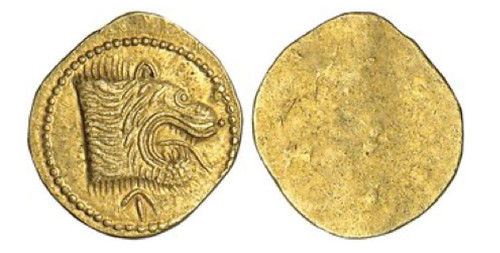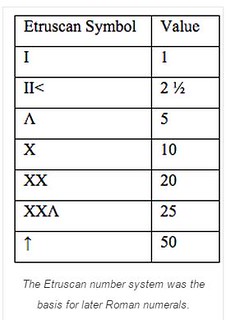
PREV ARTICLE
NEXT ARTICLE
FULL ISSUE
PREV FULL ISSUE
THE ETRUSCAN NUMBER SYSTEM ON COINAGE
Mike Markowitz published an article April 6, 2015 in CoinWeek about coinage of the ancient Etruscans. One aspect that drew my
attention was the use of their numbering system on coins; it was a forerunner of the more-familiar Roman numeral system. See the "up
arrow" on the obverse of the coin and number table shown below. -Editor

Etruscan Gold 50 Asses The people who lived in Tuscany before the Romans are often described as “enigmatic” or “mysterious.” We know them as “Etruscans” from the name that the Romans called them; they called themselves “Rasna.” The last speakers of the Etruscan language probably died out in the first century of the common era. The consensus of linguistic scholars is that Etruscan is unrelated to other known languages. A single Etruscan book – a third-century BCE ritual calendar – survived in fragmentary strips because the linen it was written on was recycled in Ptolemaic Egypt to wrap a mummy. The Roman Emperor Claudius (r. 41-54 CE) wrote a 20-volume history of the Etruscans in Greek, now lost. Blessed with fertile volcanic soil and abundant ores of iron and copper (along with forested hills providing charcoal to refine and work these metals), the Etruscans prospered, reaching a peak of cultural expression and political power in the sixth century BCE. A line of Etruscan kings ruled in Rome until they were overthrown about 509 BCE, and the Romans adopted many customs and institutions from Etruria. Like their Roman neighbors, Etruscans used crude lumps of bronze (aes rude) or cast bars with a herringbone pattern as their earliest money. Like the Carthaginians across the sea in North Africa, Etruscans only adopted coinage after their Greek neighbors had been using it for centuries. How many centuries is a matter of dispute; some numismatists put the earliest coins as far back as 500 to 450 BCE, while others insist on dates around 300 (the only thing classical numismatists love more than ancient coins is arguing about chronology.)
The lost history of the Etruscans is tragic; we are fortunate to have what little scraps remain. In situations like these the coinage of
the era takes on added historical importance. In many situations, their coins are the only surviving artifact of an era to attest to a
people's existence. -Editor
To read the complete article, see:
Wayne Homren, Editor The Numismatic Bibliomania Society is a non-profit organization promoting numismatic literature. See our web site at coinbooks.org. To submit items for publication in The E-Sylum, write to the Editor at this address: whomren@gmail.com To subscribe go to: https://my.binhost.com/lists/listinfo/esylum All Rights Reserved. NBS Home Page Contact the NBS webmaster 
|
